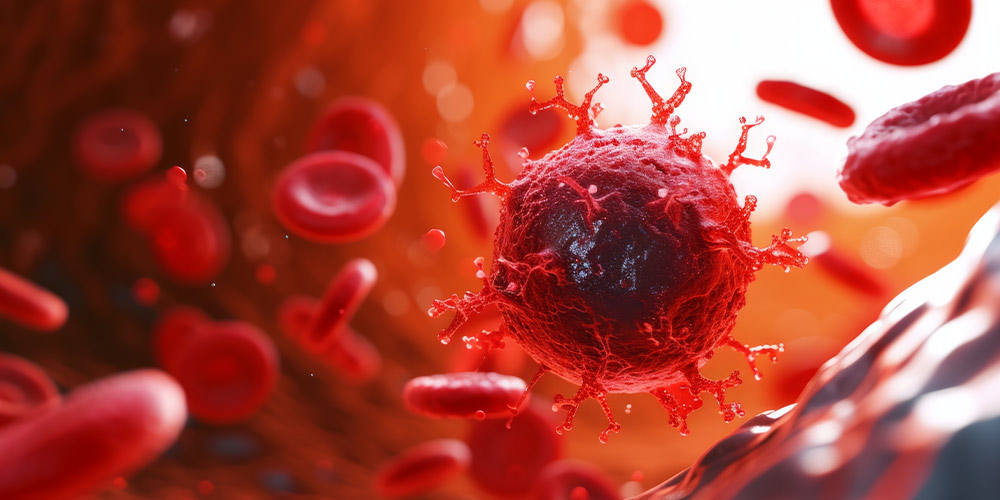
Marginal zone lymphoma (MZL) is a rare type of slow-growing non-Hodgkin lymphoma that starts in certain white blood cells called B cells. These cells play a key role in your immune system and are found in places like your lymph nodes and spleen.
Inside your lymph nodes, there are special areas called lymphoid follicles, which have two parts: the mantle zone and the marginal zone. Marginal zone lymphoma occurs when B cells in the marginal zone become abnormal and start growing uncontrollably.
MZL is more common in people over 60 and tends to affect men more often than women.
Types of Marginal Zone Lymphoma
There are three main types of MZL:
1. Mucosa-Associated Lymphoid Tissue Lymphoma (MALT Lymphoma)
a. The most common type of MZL.
b. Also known as extranodal marginal zone lymphoma.
c. Can develop in different parts of the body, such as the stomach or areas like the lungs, skin, thyroid, salivary glands, intestines, and eyes.
2. Nodal Marginal Zone Lymphoma
a. Affects the lymph nodes but may also be found in the bone marrow.
3. Splenic Marginal Zone Lymphoma
a. A rare type that affects the spleen, blood, and bone marrow.
b. Splenic MZL accounts for less than 2% of lymphoid malignancies and 20% of MZL cases. It is typically slow-growing, with a median survival of 8–10 years, but can transform into diffuse large B-cell lymphoma in 5–10% of cases.
c. Explore ongoing clinical trials of diffuse large B-cell lymphoma to access potential new treatment options.
Symptoms of Marginal Zone Lymphoma
Marginal zone lymphoma (MZL) develops slowly, and symptoms may not appear right away. When they do, they can vary depending on the type of MZL and the part of the body affected. Common symptoms include:
- Swollen lymph nodes – Painless lumps, usually in the neck, armpits, or groin.
- Fatigue – Feeling extremely tired or weak, even with enough rest.
- Unexplained weight loss – Losing weight without trying.
- Fever – Persistent or frequent fevers without an infection.
- Night sweats – Heavy sweating during sleep.
- Abdominal discomfort – If the spleen is affected, you may feel pain or fullness in your upper left abdomen.
- Frequent infections – A weakened immune system may make it harder to fight infections.
- Breathing problems or cough – If MZL affects the lungs.
- Digestive issues – Stomach pain, or nausea if the lymphoma is in the stomach (gastric MALT lymphoma).
Causes of Marginal Zone Lymphoma
The exact cause of MZL isn’t always clear, but some factors may increase the risk, including:
- Chronic infections – Long-term infections like Helicobacter pylori (H. pylori) in the stomach can trigger MALT lymphoma. Other infections, such as Hepatitis C, are also linked to MZL.
- Autoimmune diseases – Conditions like Sjögren’s syndrome or lupus may increase the risk.
- Weakened immune system – People with immune system disorders or those taking immunosuppressive drugs have a higher chance of developing MZL.
- Age and gender – MZL is more common in people over 60 and tends to affect men more than women.
- Exposure to toxins – Being exposed to certain chemicals or radiation may play a role in developing the disease.
Diagnosis of Marginal Zone Lymphoma
Diagnosing Marginal Zone Lymphoma (MZL) involves multiple steps to confirm the condition and determine its type and stage. Since MZL is slow-growing and can mimic other illnesses, doctors use a combination of physical exams, lab tests, and imaging to make an accurate diagnosis.
1. Physical Exam and Medical History
- A doctor will check for swollen lymph nodes, an enlarged spleen, or other unusual symptoms like fatigue, night sweats, or weight loss.
- They will ask about medical history, past infections (e.g., H. pylori, Hepatitis C), autoimmune diseases, and family history of lymphoma or other cancers.
2. Blood Tests and Imaging
- Blood Tests: These help assess overall health and detect any abnormal levels of white blood cells, red blood cells, or platelets. Specific tests may look for infections linked to MZL, such as H. pylori or Hepatitis C.
- CT Scans or PET Scans: These imaging tests create detailed pictures of the body to check for enlarged lymph nodes, spleen abnormalities, or tumor growth in different organs. PET scans can help detect areas with higher cancer activity.
- Ultrasound or MRI: In some cases, these imaging techniques may be used to examine the spleen, liver, or other affected organs.
3. Lymph Node or Bone Marrow Biopsy
- Lymph Node Biopsy: If swollen lymph nodes are present, doctors may remove a small sample for laboratory analysis. This helps confirm the presence of lymphoma and identify its type.
- Bone Marrow Biopsy: If lymphoma is suspected to have spread, a bone marrow biopsy is performed by taking a sample from the hip bone to check for cancerous cells.
Why These Tests Are Important
These diagnostic steps help doctors:
- Confirm if a patient has MZL or another type of lymphoma.
- Determine how advanced the disease is (staging).
- Identify the best treatment plan based on the type and spread of lymphoma.
Treatment Options for Marginal Zone Lymphoma
1. Watchful Waiting
Since Marginal Zone Lymphoma (MZL) is usually slow-growing, doctors may recommend a “watchful waiting” approach, especially if there are no severe symptoms. This means monitoring the condition with regular check-ups and tests rather than starting immediate treatment. If the lymphoma starts progressing or causing symptoms, treatment can begin.
2. Medications
- Targeted Therapy – These drugs specifically attack cancer cells while sparing healthy cells. For example, Bruton’s tyrosine kinase (BTK) inhibitors block signals that help lymphoma cells grow.
- Immunotherapy – This treatment boosts the immune system to help it recognize and destroy cancer cells. Monoclonal antibodies, such as Rituximab, are often used to target B cells affected by MZL.
3. Chemotherapy
For more aggressive cases, chemotherapy is used to kill rapidly dividing lymphoma cells. It can be given orally or through an IV. Sometimes, chemotherapy is combined with targeted therapy or immunotherapy for better results.
4. Radiation Therapy
Radiation therapy is effective when MZL is localized to a specific area. It uses high-energy beams to destroy cancer cells and shrink tumors. This treatment is often used for early-stage cases, especially in MALT lymphoma.
Read More: Immunotherapy vs Chemotherapy: Understanding the Difference in Cancer Treatment
Living with Marginal Zone Lymphoma
1. Managing Symptoms and Side Effects
- Fatigue and weakness can be managed with proper rest and light exercise.
- Medications may help control nausea, fever, or pain.
- Regular medical check-ups are essential to monitor progress and adjust treatment as needed.
2. Diet and Lifestyle Changes
- A balanced diet can help support the immune system.
- Staying hydrated and avoiding processed foods may improve overall health.
- Light physical activity, such as walking or yoga, can boost energy levels and reduce stress.
3. Emotional and Mental Health Support
- A cancer diagnosis can be overwhelming, so seeking support from family, friends, or support groups can help.
- Professional counselling or therapy may assist in managing anxiety or depression.
- Mindfulness practices, such as meditation or deep breathing exercises, can reduce stress and improve emotional well-being.
Advancing Lymphoma Treatment Through Clinical Trials
Clinical trials are actively exploring new treatments to improve outcomes for lymphoma patients. These trials evaluate innovative therapies to enhance effectiveness and reduce side effects. For example, follicular lymphoma clinical trials are investigating novel treatment combinations to improve remission rates and long-term management. Participating in a clinical trial can provide access to advanced treatments and contribute to future breakthroughs in lymphoma care.
Conclusion
In conclusion, marginal zone lymphoma is a slow-growing cancer with a generally favorable prognosis. Early diagnosis and appropriate treatment options, including targeted therapy and immunotherapy, can improve outcomes. Ongoing clinical research studies and trials continue to explore better treatments. Regular monitoring and lifestyle adjustments can help manage symptoms and enhance the quality of life for patients.
Frequently Asked Questions
Is marginal zone lymphoma curable
Some treatments may cure marginal zone lymphoma, while others induce remission, but recurrence is possible.
How serious is marginal zone lymphoma
Marginal zone lymphoma is a slow-growing, low-grade cancer with a favorable prognosis. Early diagnosis improves the outlook for most patients.
At what stage is lymphoma terminal?
Stage 4 lymphoma is the most advanced, with cancer spreading beyond the lymphatic system. While harder to treat, some cases remain manageable with treatment.







